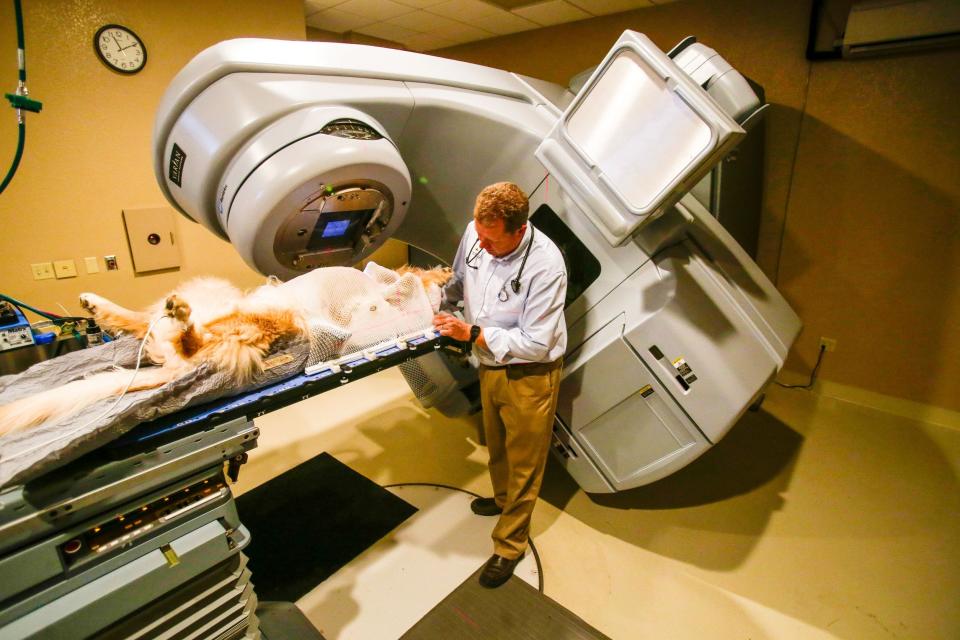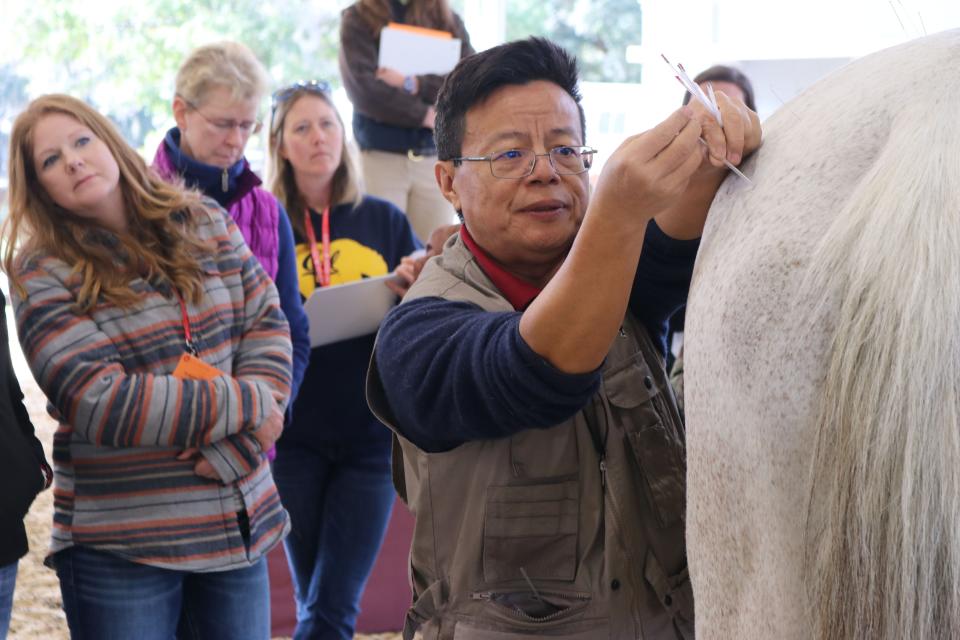Snake cancer, Fish anesthesia among topics covered at veterinary expo in Orlando
Support local journalism: Find offers for new subscribers here: Special Offers — FLORIDA TODAY.
Koala chlamydia, snake cancer and fish anesthesia were all in a conference’s work at the Veterinary Meeting & Expo, or VMX, that the North American Veterinary Community recently hosted at the Orange County Convention Center.
With approximately 1,000 sessions and an Expo Hall brimming with innovative services, products and technology, the world’s largest veterinary conference drew more than 15,000 veterinarians and veterinary nurses and technicians from around the world, all eager to learn the latest advances in an extremely complex medical field that encompasses Mother Nature’s diverse children.
The conference offers options for treatment of illnesses and disorders that just a few years ago could have been catastrophic to companion animals.
“It is the launchpad for major research and product introduction,” said NAVC CEO Gene O’Neill.
The event covered the latest life-saving, game-changing knowledge and techniques on everything from treating cancer in dogs to managing diabetes in cats.

Advances in pet radiation treatments
Veterinary radiation oncologist Dr. Eric Boshoven with PetCure Oncology discussed how stereotactic radiation, guided by computed tomography imaging, enables specialists to pinpoint and blast tumors using minimal radiation, thus reducing the number of treatments and its side effects, as well as the need for anesthesia.
The technology appeared in human medicine in the early 1990s and has taken off in veterinary medicine recently. Instead of going through three to four weeks of radiation — and 15-20 anesthesias —the animal undergoes just one to three treatments. While blister-like lesions are common with traditional radiation, they are rare with stereotactic.
The treatment has been particularly helpful in the treatment of nasal, eye and brain tumors, cancers that historically have been extremely difficult to treat.
More: Fur-la-la-la-la: These holiday gifts will keep cats and dogs entertained all year long
More: Indialantic may create dog-friendly beach at Sunrise Park on a six-month trial basis
“We’re seeing light,” said Boshoven. “We have hope. We are extending the quality of life.”
The treatment has even been used successfully with zoo animals, including lions, sea lions and the Louisiana State University tiger mascot.
Boshoven also touched on the use of immunotherapy in treatment of companion animals with cancer.
“If we can get the body to treat the cancer, it will help us, and with less toxicity,” he said.
Tackling feline diabetes
Feline diabetes was another issue the conference tackled. Kitties are three times more likely than dogs to develop diabetes mellitus for the same reason humans are prone to it
“Many cats lead cushy lives, leading to obesity, which makes them more likely to develop diabetes,” said NAVC chief veterinary officer Dr. Dana Varble.
Varble noted that cats now have the option of wearable diabetes monitors.
“They are discs implanted under the skin and connected to a smart phone app,” said Varble. “They’re affordable and easy to use.”

Acupuncture for animals
Not all things discussed at the conference were new. Integrating the ancient practice of acupuncture with western medicine can contribute to pets’ quality of life, particularly for veterinary geriatric or cancer patients.
Session leader Dr. Huisheng Xie, professor emeritus at the University of Florida, noted that integrating acupuncture into the treatment plan for veterinary cancer patients in many cases may extend a good quality of life for up to five years longer, good news to patients and pet parents. Acupuncture has been successfully used to treat a wide range of animals including dogs, cats, horses, elephants and birds.
What's new in pet insurance
A wider range of treatment modalities brings up the subject of pet insurance to pay for these services.
“Pet insurance is becoming more available and affordable and tends to cover “surprises,” said Varble.
Companies such as Nationwide offer pet insurance, with up to 90 percent reimbursement.
Telehealth for four-legged friends
Exhibitor VetTriage addressed another emerging veterinary field trend: telehealth. The company offers 24/7 on-demand video teletriage sessions for any species and any location with U.S.-licensed veterinarians. Pet parents connect to the company’s proprietary video system without needing an appointment or software download.
Advancements in treating parasites
Any conference about pets has to address the pesky parasites that tend to gravitate to the fur babies. Parasites are on the rise and with them, zoonotic diseases, as opportunistic animal diseases that migrate to humans.
“We don’t know what we don’t know, and there’s much to learn about parasites that could impact animal and human health now and in the future,” said Dr. Christian Leutenegger of Antech Diagnostics.
“While we are aware of emerging issues like treatment-resistant hookworm infections, there could be latent risks from parasites that we once believed to be insignificant," Leutenegger said. “The COVID-19 pandemic has shown us — with vivid clarity — how human and animal health are interconnected, the danger and speed of mutations, and the critical need for sensitive, fast, affordable diagnostic testing.”
At VMX, Antech rolled out KeyScreen GI Parasite PCR, a molecular diagnostic test that detects 20 different parasites, including drug-resistant hookwork and zoonotic Giardia, making advanced molecular parasite screening practical during routine wellness exams. Molecular testing enables a look into the DNA of a parasite.
“I like to say that molecular testing can tell you what color eyes the parasite has,” said Leutenegger. “Current and unrecognized threats demand this level of precision to ensure animal and human wellbeing.”
Heartworm, ticks and flees, oh, my!
Speaking of parasites, a triple threat against heartworm, ticks and fleas, made its debut at VMX. Simparica Trio, manufactured by Zoetis, is a once-a-month prescription chewable that protects dogs against those three types of parasitic menaces.
In regards to ticks, parasitology expert Dr. Chris Adolph noted that out of sight is not out of mind, since ticks go through two stages before reaching their more visible — and grosser — adulthood. Using a CDC photo of miniscule ticks the size of a poppy seed crawling over a muffin, Adolph emphasized the danger these parasites pose even before they are readily visible.
“They can crawl around for hours and people never see these,” he said.
Importance of nurses and vet techs
VMX also introduced an initiative to raise consumer awareness of the role veterinary nurses and credentialed technicians play in veterinary practices. The educational campaign resulted from a survey conducted by Atomik Research on behalf of NAVC that many many pet owners were unaware of or did not understand the broad range of services these medical professionals perform.
“They are not just helpers and assistants,” said O’Neill. “They are phlebotomists, anesthetists, ultrasonographers, surgical technicians, dental hygienists and more.”
Licensed veterinary medical technician Leslie Wereszczak, director of emergency critical care with the University of Tennessee College of Veterinary Medicine, took center stage to discuss the role of technicians during emergency C-sections and even with routine prenatal care.
Another speaker, emergency and critical nurse Courtney Waxman, leads a task force on a certification process for pet owners to become trained in pet CPR.
“As veterinary nurses, we make a significant difference,” said Wereszczak.
The field of veterinary medicine is rapidly evolving, mimicking and often building upon, advances in human medicine.
“We’ve come a long way,” said Boshoven.
Sonnenberg is a Melbourne-based lifestyles and travel writer.
Support local journalism: Find offers for new subscribers here: Special Offers — USATodayNetwork.
This article originally appeared on Florida Today: Snake cancer to fish anesthesia: Expo covered what's new in veterinary medicine

